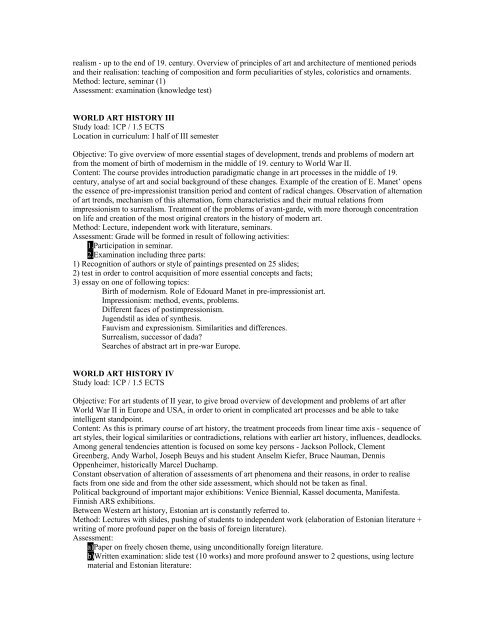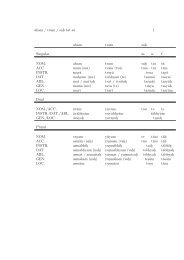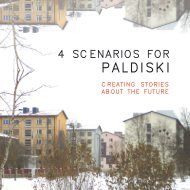Fine Art - Eesti Kunstiakadeemia / Estonian Academy of Arts
Fine Art - Eesti Kunstiakadeemia / Estonian Academy of Arts
Fine Art - Eesti Kunstiakadeemia / Estonian Academy of Arts
Create successful ePaper yourself
Turn your PDF publications into a flip-book with our unique Google optimized e-Paper software.
ealism - up to the end <strong>of</strong> 19. century. Overview <strong>of</strong> principles <strong>of</strong> art and architecture <strong>of</strong> mentioned periods<br />
and their realisation: teaching <strong>of</strong> composition and form peculiarities <strong>of</strong> styles, coloristics and ornaments.<br />
Method: lecture, seminar (1)<br />
Assessment: examination (knowledge test)<br />
WORLD ART HISTORY III<br />
Study load: 1CP / 1.5 ECTS<br />
Location in curriculum: I half <strong>of</strong> III semester<br />
Objective: To give overview <strong>of</strong> more essential stages <strong>of</strong> development, trends and problems <strong>of</strong> modern art<br />
from the moment <strong>of</strong> birth <strong>of</strong> modernism in the middle <strong>of</strong> 19. century to World War II.<br />
Content: The course provides introduction paradigmatic change in art processes in the middle <strong>of</strong> 19.<br />
century, analyse <strong>of</strong> art and social background <strong>of</strong> these changes. Example <strong>of</strong> the creation <strong>of</strong> E. Manet’ opens<br />
the essence <strong>of</strong> pre-impressionist transition period and content <strong>of</strong> radical changes. Observation <strong>of</strong> alternation<br />
<strong>of</strong> art trends, mechanism <strong>of</strong> this alternation, form characteristics and their mutual relations from<br />
impressionism to surrealism. Treatment <strong>of</strong> the problems <strong>of</strong> avant-garde, with more thorough concentration<br />
on life and creation <strong>of</strong> the most original creators in the history <strong>of</strong> modern art.<br />
Method: Lecture, independent work with literature, seminars.<br />
Assessment: Grade will be formed in result <strong>of</strong> following activities:<br />
1.Participation in seminar.<br />
2.Examination including three parts:<br />
1) Recognition <strong>of</strong> authors or style <strong>of</strong> paintings presented on 25 slides;<br />
2) test in order to control acquisition <strong>of</strong> more essential concepts and facts;<br />
3) essay on one <strong>of</strong> following topics:<br />
Birth <strong>of</strong> modernism. Role <strong>of</strong> Edouard Manet in pre-impressionist art.<br />
Impressionism: method, events, problems.<br />
Different faces <strong>of</strong> postimpressionism.<br />
Jugendstil as idea <strong>of</strong> synthesis.<br />
Fauvism and expressionism. Similarities and differences.<br />
Surrealism, successor <strong>of</strong> dada?<br />
Searches <strong>of</strong> abstract art in pre-war Europe.<br />
WORLD ART HISTORY IV<br />
Study load: 1CP / 1.5 ECTS<br />
Objective: For art students <strong>of</strong> II year, to give broad overview <strong>of</strong> development and problems <strong>of</strong> art after<br />
World War II in Europe and USA, in order to orient in complicated art processes and be able to take<br />
intelligent standpoint.<br />
Content: As this is primary course <strong>of</strong> art history, the treatment proceeds from linear time axis - sequence <strong>of</strong><br />
art styles, their logical similarities or contradictions, relations with earlier art history, influences, deadlocks.<br />
Among general tendencies attention is focused on some key persons - Jackson Pollock, Clement<br />
Greenberg, Andy Warhol, Joseph Beuys and his student Anselm Kiefer, Bruce Nauman, Dennis<br />
Oppenheimer, historically Marcel Duchamp.<br />
Constant observation <strong>of</strong> alteration <strong>of</strong> assessments <strong>of</strong> art phenomena and their reasons, in order to realise<br />
facts from one side and from the other side assessment, which should not be taken as final.<br />
Political background <strong>of</strong> important major exhibitions: Venice Biennial, Kassel documenta, Manifesta.<br />
Finnish ARS exhibitions.<br />
Between Western art history, <strong>Estonian</strong> art is constantly referred to.<br />
Method: Lectures with slides, pushing <strong>of</strong> students to independent work (elaboration <strong>of</strong> <strong>Estonian</strong> literature +<br />
writing <strong>of</strong> more pr<strong>of</strong>ound paper on the basis <strong>of</strong> foreign literature).<br />
Assessment:<br />
a)Paper on freely chosen theme, using unconditionally foreign literature.<br />
b)Written examination: slide test (10 works) and more pr<strong>of</strong>ound answer to 2 questions, using lecture<br />
material and <strong>Estonian</strong> literature:






